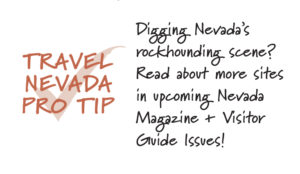Rock Out
February – April 2022
Dig these amazing mineral finds.
BY MEGG MUELLER
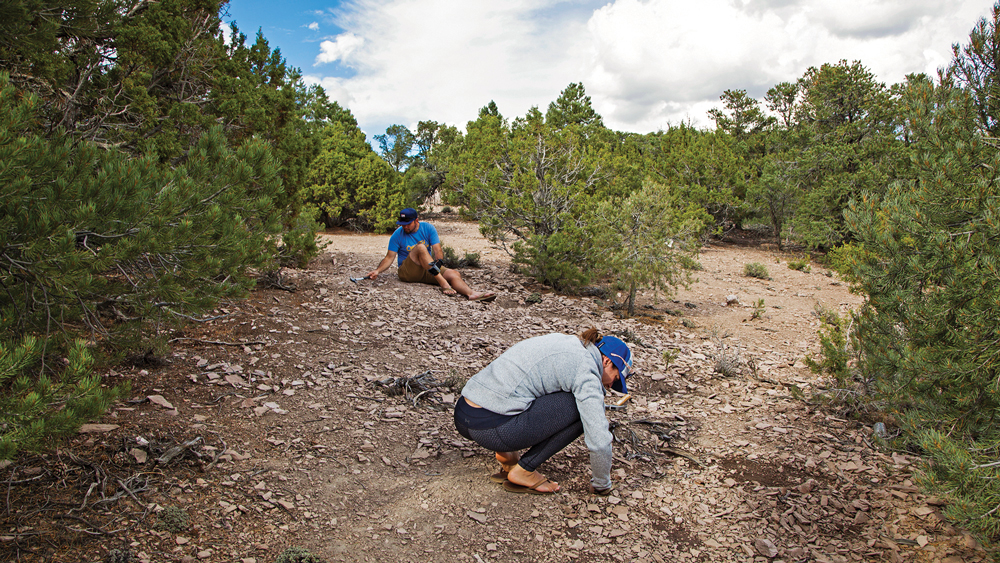
Getting down—and maybe dirty—in the hills of Nevada is one of the easiest, least expensive, and most rewarding pastimes you’ll ever find. Hunting for gems and minerals can be an easy day trip from many towns, including Fallon, Ely, and Mesquite.

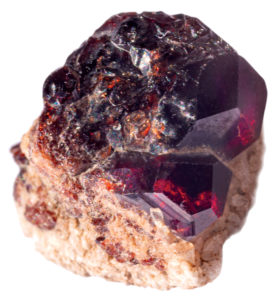 WHERE THE RED STONE GROWS
WHERE THE RED STONE GROWS
Once, the ground in Nevada was littered with nuggets of gold and rich veins of silver (or so the history books tell us). It’s a little tougher to find those precious metals lying about today, but if a beautiful gemstone will do, look no further than Garnet Hill just outside of Ely in White Pine County.
If an entire hill named after a gem isn’t enough, Garnet Hill is a developed day-use area complete with accessible bathrooms and four picnic sites with grills. But let’s be honest, you didn’t come here for the picnic—you came for the garnets.
These almandine garnets are made of iron aluminum silicate and generally have a rich dark color. Flashes of red burn within the multifaceted stones that can be found lying on the ground. You read that correctly; they can be found on the ground as well as in the rhyolite rocks that populate the hillsides.
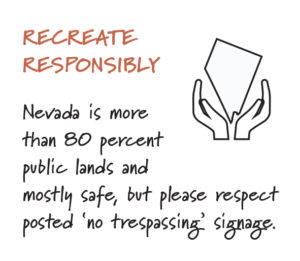 Locating the gemstones within the rhyolite can take practice and requires a rock hammer and some finesse. Don’t smash willy-nilly or you can easily bust up the gems you seek. Looking for rocks with holes or pockets is a decent indicator, albeit not foolproof. The garnets found lying on the ground have extricated themselves from these pockets, so it can follow there will be others in nearby slabs of light-colored rhyolite, but not always.
Locating the gemstones within the rhyolite can take practice and requires a rock hammer and some finesse. Don’t smash willy-nilly or you can easily bust up the gems you seek. Looking for rocks with holes or pockets is a decent indicator, albeit not foolproof. The garnets found lying on the ground have extricated themselves from these pockets, so it can follow there will be others in nearby slabs of light-colored rhyolite, but not always.
 Close inspection is also required for finding the loose stones. Search further away from the parking lot and look for stone deposits anywhere it appears water has been flowing.
Close inspection is also required for finding the loose stones. Search further away from the parking lot and look for stone deposits anywhere it appears water has been flowing.
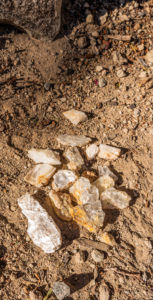
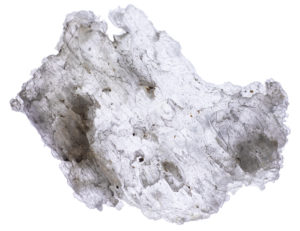 SPARKLES IN THE DESERT
SPARKLES IN THE DESERT
One of the easiest rocks to hunt for is selenite, especially if you go on a sunny day when the glint off the crystals will do its best to blind you. Kids love its easy-to-spot, sparkly properties.
Selenite is found across Nevada, but good places to hunt include the Weeks site near Fernley and numerous locations within the Gold Butte National Monument at Mesquite.
Selenite is a variety of gypsum, and specimens have been found up to 39 feet long in caves in Mexico. You likely won’t find anything that long, but scattered all over the ground, the mostly clear, often perfectly flat material shimmers  beautifully in the sun. The mineral is fairly soft, a 2 on the Mohs hardness scale, which means you can scratch it with your fingernail, and it has some flexibility but can be broken. Selenite is generally clear—depending on the other trace minerals that might be in the material—and has been used as windowpanes.
beautifully in the sun. The mineral is fairly soft, a 2 on the Mohs hardness scale, which means you can scratch it with your fingernail, and it has some flexibility but can be broken. Selenite is generally clear—depending on the other trace minerals that might be in the material—and has been used as windowpanes.
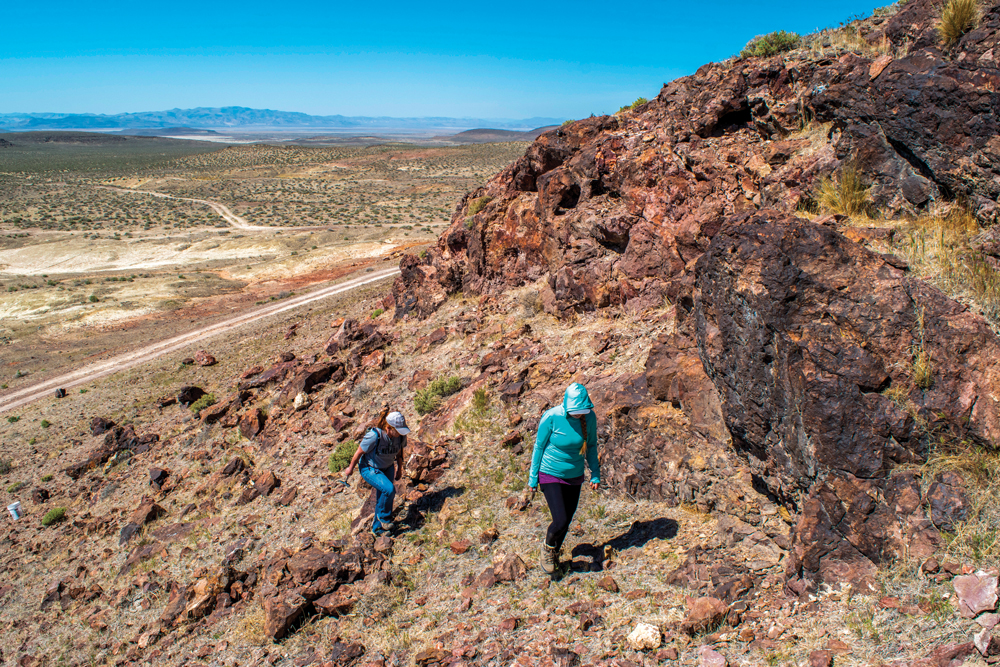
 WHAT A ‘WONDER’FUL ROCK
WHAT A ‘WONDER’FUL ROCK
Wonderstone is made up of bands of orange, red, brown, purple, and creams—as if Nevada’s rainbow-striped hills are presented in miniature form. Wonderstone Mountain (or Rainbow Mountain, as it’s also called) is easy to access and less than an hour east of Fallon.
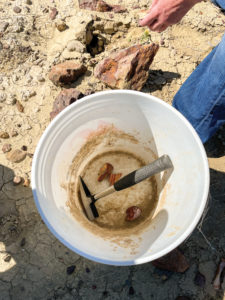 Head east from the Grimes Point/Hidden Cave Archaeological Site turnoff until you spy the orange hills. Keep your eye on the ground: you’ll see rocks of every color and size, and the unmistakable colored layers of Wonderstone are everywhere.
Head east from the Grimes Point/Hidden Cave Archaeological Site turnoff until you spy the orange hills. Keep your eye on the ground: you’ll see rocks of every color and size, and the unmistakable colored layers of Wonderstone are everywhere.
You can see brilliant patterns made up of stripes, squares, and circles, which appear as if painted by artists. The ground samples are enough to take your breath away, but the larger rock formations are truly incredible.
There are numerous deposits of Wonderstone in the surrounding hills, so it’s easy to spread out and find just what you’re looking for. Agate, green rhyolite, and even jasper have also been found in the area, along with volcanic bombs— small rocks formed when lava was 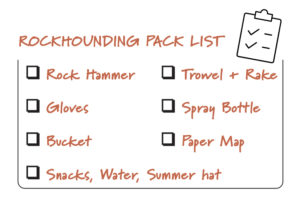 ejected from ancient volcanos—that are most likely from nearby Soda Lake.
ejected from ancient volcanos—that are most likely from nearby Soda Lake.
Part of what makes rockhounding in Nevada so awesome is the amount of public land available. It is so easy to get out and explore, plus the desert has very little dense vegetation, so rocks can be found much more easily. With so many different rocks to find in just this one area, the only tough part of the day is deciding where to look first. Oh, and how much you can possibly bring home with you.
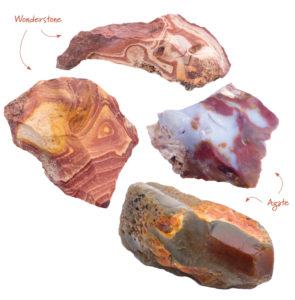 DIG IT, THE RIGHT WAY
DIG IT, THE RIGHT WAY
There’s no greater tip than to respect the land. Always get permission to search on private property, and leave no trace. Make sure you have the right vehicle for the terrain, carry plenty of water and gas, and always tell someone where you’re headed.
Rockhounding can be easy thanks to the tons of great specimens to be found, and it’s so simple: do a little research and point your vehicle in the right direction. At the end of the road it’s just you and your thoughts as you walk through serene landscapes, gathering stones, and, hopefully, a sense of how beautifully made this state truly is.
